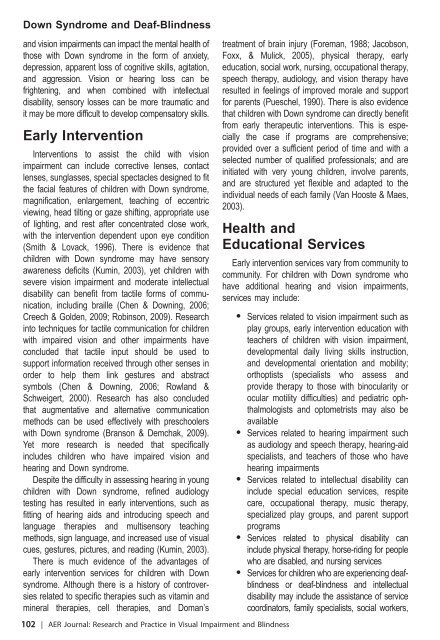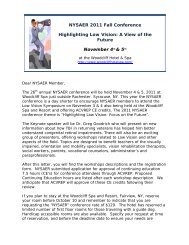Association for Education and Rehabilitation of the ... - AER Online
Association for Education and Rehabilitation of the ... - AER Online
Association for Education and Rehabilitation of the ... - AER Online
You also want an ePaper? Increase the reach of your titles
YUMPU automatically turns print PDFs into web optimized ePapers that Google loves.
Down Syndrome <strong>and</strong> Deaf-Blindness<br />
<strong>and</strong> vision impairments can impact <strong>the</strong> mental health <strong>of</strong><br />
thosewithDownsyndromein<strong>the</strong><strong>for</strong>m<strong>of</strong>anxiety,<br />
depression, apparent loss <strong>of</strong> cognitive skills, agitation,<br />
<strong>and</strong> aggression. Vision or hearing loss can be<br />
frightening, <strong>and</strong> when combined with intellectual<br />
disability, sensory losses can be more traumatic <strong>and</strong><br />
it may be more difficult to develop compensatory skills.<br />
Early Intervention<br />
Interventions to assist <strong>the</strong> child with vision<br />
impairment can include corrective lenses, contact<br />
lenses, sunglasses, special spectacles designed to fit<br />
<strong>the</strong> facial features <strong>of</strong> children with Down syndrome,<br />
magnification, enlargement, teaching <strong>of</strong> eccentric<br />
viewing, head tilting or gaze shifting, appropriate use<br />
<strong>of</strong> lighting, <strong>and</strong> rest after concentrated close work,<br />
with <strong>the</strong> intervention dependent upon eye condition<br />
(Smith & Lovack, 1996). There is evidence that<br />
children with Down syndrome may have sensory<br />
awareness deficits (Kumin, 2003), yet children with<br />
severe vision impairment <strong>and</strong> moderate intellectual<br />
disability can benefit from tactile <strong>for</strong>ms <strong>of</strong> communication,<br />
including braille (Chen & Downing, 2006;<br />
Creech & Golden, 2009; Robinson, 2009). Research<br />
into techniques <strong>for</strong> tactile communication <strong>for</strong> children<br />
with impaired vision <strong>and</strong> o<strong>the</strong>r impairments have<br />
concluded that tactile input should be used to<br />
support in<strong>for</strong>mation received through o<strong>the</strong>r senses in<br />
order to help <strong>the</strong>m link gestures <strong>and</strong> abstract<br />
symbols (Chen & Downing, 2006; Rowl<strong>and</strong> &<br />
Schweigert, 2000). Research has also concluded<br />
that augmentative <strong>and</strong> alternative communication<br />
methods can be used effectively with preschoolers<br />
with Down syndrome (Branson & Demchak, 2009).<br />
Yet more research is needed that specifically<br />
includes children who have impaired vision <strong>and</strong><br />
hearing <strong>and</strong> Down syndrome.<br />
Despite <strong>the</strong> difficulty in assessing hearing in young<br />
children with Down syndrome, refined audiology<br />
testing has resulted in early interventions, such as<br />
fitting <strong>of</strong> hearing aids <strong>and</strong> introducing speech <strong>and</strong><br />
language <strong>the</strong>rapies <strong>and</strong> multisensory teaching<br />
methods, sign language, <strong>and</strong> increased use <strong>of</strong> visual<br />
cues, gestures, pictures, <strong>and</strong> reading (Kumin, 2003).<br />
There is much evidence <strong>of</strong> <strong>the</strong> advantages <strong>of</strong><br />
early intervention services <strong>for</strong> children with Down<br />
syndrome. Although <strong>the</strong>re is a history <strong>of</strong> controversies<br />
related to specific <strong>the</strong>rapies such as vitamin <strong>and</strong><br />
mineral <strong>the</strong>rapies, cell <strong>the</strong>rapies, <strong>and</strong> Doman’s<br />
102 | <strong>AER</strong> Journal: Research <strong>and</strong> Practice in Visual Impairment <strong>and</strong> Blindness<br />
treatment <strong>of</strong> brain injury (Foreman, 1988; Jacobson,<br />
Foxx, & Mulick, 2005), physical <strong>the</strong>rapy, early<br />
education, social work, nursing, occupational <strong>the</strong>rapy,<br />
speech <strong>the</strong>rapy, audiology, <strong>and</strong> vision <strong>the</strong>rapy have<br />
resulted in feelings <strong>of</strong> improved morale <strong>and</strong> support<br />
<strong>for</strong> parents (Pueschel, 1990). There is also evidence<br />
that children with Down syndrome can directly benefit<br />
from early <strong>the</strong>rapeutic interventions. This is especially<br />
<strong>the</strong> case if programs are comprehensive;<br />
provided over a sufficient period <strong>of</strong> time <strong>and</strong> with a<br />
selected number <strong>of</strong> qualified pr<strong>of</strong>essionals; <strong>and</strong> are<br />
initiated with very young children, involve parents,<br />
<strong>and</strong> are structured yet flexible <strong>and</strong> adapted to <strong>the</strong><br />
individual needs <strong>of</strong> each family (Van Hooste & Maes,<br />
2003).<br />
Health <strong>and</strong><br />
<strong>Education</strong>al Services<br />
Early intervention services vary from community to<br />
community. For children with Down syndrome who<br />
have additional hearing <strong>and</strong> vision impairments,<br />
services may include:<br />
N Services related to vision impairment such as<br />
play groups, early intervention education with<br />
teachers <strong>of</strong> children with vision impairment,<br />
developmental daily living skills instruction,<br />
<strong>and</strong> developmental orientation <strong>and</strong> mobility;<br />
orthoptists (specialists who assess <strong>and</strong><br />
provide <strong>the</strong>rapy to those with binocularity or<br />
ocular motility difficulties) <strong>and</strong> pediatric ophthalmologists<br />
<strong>and</strong> optometrists may also be<br />
available<br />
N Services related to hearing impairment such<br />
as audiology <strong>and</strong> speech <strong>the</strong>rapy, hearing-aid<br />
specialists, <strong>and</strong> teachers <strong>of</strong> those who have<br />
hearing impairments<br />
N Services related to intellectual disability can<br />
include special education services, respite<br />
care, occupational <strong>the</strong>rapy, music <strong>the</strong>rapy,<br />
specialized play groups, <strong>and</strong> parent support<br />
programs<br />
N Services related to physical disability can<br />
include physical <strong>the</strong>rapy, horse-riding <strong>for</strong> people<br />
who are disabled, <strong>and</strong> nursing services<br />
N Services <strong>for</strong> children who are experiencing deafblindness<br />
or deaf-blindness <strong>and</strong> intellectual<br />
disability may include <strong>the</strong> assistance <strong>of</strong> service<br />
coordinators, family specialists, social workers,







